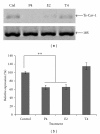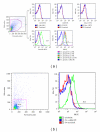Sex steroids effects on the molting process of the helminth human parasite Trichinella spiralis
- PMID: 22162638
- PMCID: PMC3228608
- DOI: 10.1155/2011/625380
Sex steroids effects on the molting process of the helminth human parasite Trichinella spiralis
Erratum in
- J Biomed Biotechnol. 2013;2013:586951
Abstract
We evaluated the in vitro effects of estradiol, progesterone, and testosterone on the molting process, which is the initial and crucial step in the development of the muscular larvae (ML or L1) to adult worm. Testosterone had no significative effect on the molting rate of the parasite, however, progesterone decreased the molting rate about a 50% in a concentration- and time-independent pattern, while estradiol had a slight effect (10%). The gene expression of caveolin-1, a specific gene used as a marker of parasite development, showed that progesterone and estradiol downregulated its expression, while protein expression was unaffected. By using flow citometry, a possible protein that is recognized by a commercial antiprogesterone receptor antibody was detected. These findings may have strong implications in the host-parasite coevolution, in the sex-associated susceptibility to this infection and could point out to possibilities to use antihormones to inhibit parasite development.
Figures






References
-
- Olster DH, Blaustein JD. Development of steroid-induced lordosis in female guinea pigs: effects of different estradiol and progesterone treatments, clonidine, and early weaning. Hormones and Behavior. 1989;23(1):118–129. - PubMed
-
- Pfaff DW, Freidin MM, Wu-Peng XS, Yin J, Zhu YS. Competition for DNA steroid response elements as a possible mechanism for neuroendocrine integration. Journal of Steroid Biochemistry and Molecular Biology. 1994;49(4–6):373–379. - PubMed
-
- Cabrera-Muñoz E, González-Arenas A, Saqui-Salces M, et al. Regulation of progesterone receptor isoforms content in human astrocytoma cell lines. Journal of Steroid Biochemistry and Molecular Biology. 2009;113(1-2):80–84. - PubMed
-
- Escobedo G, Roberts CW, Carrero JC, Morales-Montor J. Parasite regulation by host hormones: an old mechanism of host exploitation? Trends in Parasitology. 2005;21(12):588–593. - PubMed
-
- Guerra-Araiza C, Coyoy-Salgado A, Camacho-Arroyo I. Sex differences in the regulation of progesterone receptor isoforms expression in the rat brain. Brain Research Bulletin. 2002;59(2):105–109. - PubMed
Publication types
MeSH terms
Substances
LinkOut - more resources
Full Text Sources

